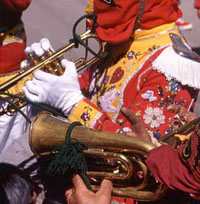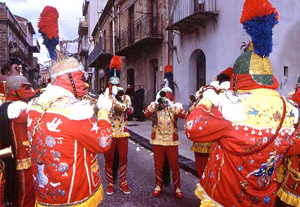|
San Fratello is a small village situated in the Nebrodi hills bordering the provinces of Messina and Palermo. A rather peculiar performance is held there, from the Wednesday before Easter up until Good Friday, unknown elsewhere in Sicily, called the “Feast of the Jews.” The leading actors are the village menfolk, who freely roam the streets playing loudly and menacingly as they swing a thick chain known as the ‘discipline’.
“Nei giorni di Giovedì e Venerdì della settimana santa […] si mettono in giro pel Comune un buon numero di mandriani travestiti in una certa foggia carnevalesca, che volgarmente si chiama di Giudei. La voce ‘carnevalesca’ non è esagerata, perché non potrebbe altrimenti appellarsi che da Carnevale i vari pezzi di quel costume. Un sacco con due buchi per gli occhi, ed una maglia di pelle nera lucida copre il capo, dietro il quale si rovescia a forma di cappuccio, pendente per via di una enorme nappa fino ai polpacci delle gambe, una specie di giubba egualmente rossa, che va a congiungersi alla vita con uno stretto paio di brache; gambali di stoffa gialla scendono fino ai calzoni: un insieme stranissimo, reso anche tale da un mazzo di catene a maglie schiacciate, triste avanzo di discipline, che i Giudei agitano e scuotono per accrescere il rumore, lo strepito ed il baccano onde assordano quanti incontrano e quanti essi si precipitano ad incontrare. Qualcuno di loro porta una tromba, che suona ad ogni crocevia, ad ogni vicolo, o chiassuolo nel quale imbocca, accrescendone gli effetti con lo scroscio della catena. Aggruppandosi, dividendosi, raggruppandosi innanzi le case, innanzi le chiese, si mescolano alla folla dei devoti, vi si fanno strada, sguisciando, sgambettando, saltando e facendo a chi più può nel raggiungere un posto, una chiesa, un orto, un giardino fuori il Comune, non curandosi di manomettere quanto incontrano” (Pitrè 1913 - 1978: 226-228). [“On the days of Thursday and Friday of the Holy Week […] a rowdy mob of shepherds roam the town’s streets dressed up in carnival-like clothing, which is known as ‘of the Jews’. The term ‘carnivalesque’ is no exaggeration, because the various items of that costume could not be named otherwise. A sack from which two holes have been cut out for the eyes, and shiny leather garment covering the head, behind which it drops in a hood-like fashion; a kind of red jacket hangs down by means of an enormous tassel right down to the calves, joined at the waist to a pair of tight trousers; leggings made with yellow fabric go straight down the trousers: a very strange array, made all the more so by a bunch of flat chains, a sad relic of the inflicted ‘discipline’, that the Jews swirl around and shake to make more clatter, and the cries and the racket they make deafening the people who come across them and those who come rushing over to meet up with them. Some of them carry a trumpet, which they play at every crossroads, at every alleyway, or track they head down, amplifying the effects with the rattling of the chains. They group together, break up, and re-group before the houses, before the churches, they mingle among the crowd of devotees, they make their way forward, bobbing and weaving, kicking, jumping and playing at who can get to a place first, a church, a vegetable garden, a park outside the borough’s territory, not cng to leave undamaged whatever comes before their paths”].
By progressively amplifying the spectacular but also the liberating force of that rite, the popular tradition took possession of that moment, to the extent that by the end of the 19th century episodes of a completely different nature were being recorded:
This ritual, known as the Earthquake or Scurdàte or Tremmete (the Tremor) or Bbatte porte (Bang the doors) in the different local dialects and widespread throughout Italy, from the North to the southern islands, is variously interpreted by the scholars. In some cases, it is seen as an imitation of the cries and the havoc that erupted during the seizing of Christ by the soldiers (the Jews), or as the beatings inflicted upon Barabas, or even as the re-enactment of the scourging of Jesus, or as Nature’s reaction to the death of the Son of God (see Perrotta 1986; Sordi 1997; Mascia 2001).
At San Fratello, could the amplification of the liturgical event have grown so disproportionately, to the point of releasing the rite from the limits imposed by the ecclesiastical settings? The cry of the Jews, which had brought the world of man into contact with the untouchable one of the sacred, has perhaps taken a backwards route, taking the earthly gestures back to those of daily life in order to made them sacred in the profanation? |

